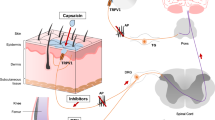Potassium (K+) channels constitute the most diverse class of ion channels; these channels are especially important for regulation of the neuronal excitability and provide signaling activity in a variety of ways. These channels are major determinants of the membrane excitability, influencing the resting potential of the membranes, waveforms and frequencies of action potentials, and thresholds of excitation. Voltagegated K+ channels do not exist as independent units merely responding to changes in the transmembrane potential; these are macromolecular complexes able to integrate a great variety of cellular signals that provide fine tuning of channel activities. Compounds that change K+ channel properties are commonly employed as therapeutic agents in a number of pathologies, in particular arrhythmias, cancer, and neurological disorders (psychoses, epilepsy, stroke, and Alzheimer’s disease).
Similar content being viewed by others
References
P. G. Kostyuk, Plasticity in Nerve Cell Function, Clarendon Press, Oxford Univ. Press, Oxford (1998).
P. G. Kostyuk, Calcium Ions in Nerve Cell Function, Oxford Univ. Press, Oxford (1992).
P. G. Kostyuk and E. A. Lukyanetz, “Mechanisms of antagonistic action of internal Ca2+ on serotonin-induced potentiation of Ca2+ current in Helix neurones,” Pflügers Arch., 424, 73-83 (1993).
D. Debanne, ”Plasticity of neuronal excitability in vivo,” J. Physiol., 587, No. 13, 3057-3058 (2009).
N. C. Spitzer, “New dimensions of neuronal plasticity,” Nat. Neurosci., 2, No. 6, 489-491 (1999).
R. Narayanan and D. Johnston, “The ascent of channels with memory,” Neuron, 60, No. 3, 735-738.
F. Bezanilla, “Ion channels: from conductance to structure,” Neuron, 60, No. 3, 456-468 (2008).
D. A. Doyle, J. M. Carabal, R. A. Pfuetzner, et al., “The structure of the potassium channel: molecular basis of K+ conduction and selectivity,” Science, 280, 69-77 (1998).
S. Choe, “Potassium channel structures,” Nat. Rev. Neurosci., 3, No. 2, 115-121 (2002).
R. MacKinnon, “Potassium channels,” FEBS Lett., 555, No. 3, 62-65 (2003).
W. A. Coetzee, Y. Amarillo, J. Chiu, et al., “Molecular diversity of K+ channels,” Ann. New York Acad. Sci., 868, No. 5, 233-285 (1999).
D. N. Papazian, “Potassium channels: some assembly required,” Neuron, 23, 7-10 (1999).
I. S. Magura and I. Z. Zamekhovsky, “Repetitive firing in molluscan giant neurons,” J. Exp. Biol., 59, No. 3, 767-780 (1973).
J. N. MacLean, Y. Zhang, B. R. Johnson, and R. M. Harris-Warrick, “Activity-independent homeostasis in rhythmically active neurons,” Neuron, 37, No. 6, 109-120 (2003).
J. R. Martens, K. O’Connell, and M. Tamkun, “Targeting of ion channels to membrane microdomains: localization of Kv channels to lipid rafts,” Trends Pharmacol. Sci., 25, 16-21 (2004).
D. L. Black, “Protein diversity from alternative splicing: a challenge for bioinformatics and post-genome biology,” Cell, 103, 367-370 (2000).
Y. Li, S. Y. Um, and T. V. McDonald, “Voltage-gated potassium channels: regulation by accessory subunits,” Neuroscientist, 12, No. 1, 199-209 (2006).
L. L. Isom, K. S. De Jongh, and W. A. Catterall, “Auxilary subunits of voltage-gated ion channels,” Neuron, 12, No. 3, 1183-1194 (1994).
G. C. L. Bett and R. L. Rasmusson, “Modification of K channel–drug interactions by ancillary subunits,” J. Physiol., 586, No. 4, 929-950 (2008).
D. Johnston, D. A. Hoffman, and J. C. Magee, “Dendritic potassium channels in hippocampal pyramidal neurons,” J. Physiol., 525, No. 1, 75-81 (2000).
P. J. Spruston, “Pyramidal neurons: dendritic structure and synaptic integration,” Nat. Rev. Neurosci., 9, 206-221 (2008).
T. Baukrowits and G. Yellen, “Modulation of K current by frequency and external [K]: A tale of two inactivation mechanisms,” Neuron, 15, 951-960 (1995).
K. G. Klemic, C. C. Shieh, G. E. Kirsch, and S. W. Jones, “Inactivation of Kv2.1 potassium channels,” Biophys. J., 74, 1779-1789 (1998).
K.G. Klemic, G. E. Kirsch, and S. W. Jones, “U-type inactivation of Kv3.1 and Shaker potassium chаnnels,” Biophys. J., 81, 814-826 (2000)
I. S. Magura, V. V. Kucher, and N. Y. Boiko, “Voltage-operated potassium channels and mechanisms controlling their activity,” Neurophysiology, 36, 285-292 (2004).
P. G. Patil, D. L. Brody, and D. T. Yue, “Preferential closed-state inactivation of neuronal calcium channels,” Neuron, 20, No. 4, 1027–1038 (1998).
I. S. Magura, O. A. Krishtal, and A. G. Valeyev, “Behaviour of delayed current under long duration voltage clamp in snail neurons,” Compar. Biochem. Physiol., Ser. A, 40, 715-722 (1971).
R. W. Aldrich, “Inactivation of voltage-gated delayed potassium current in molluscan neurons: a kinetic model,” Biophys. J., 36, No. 2, 519-532 (1981).
M. Ma and J. Koester, “The role of K currents in frequency-dependent spike broadening in Aplysia R20 neurons: A dynamic-clamp analysis,” J. Neurosci., 16, 4089-4102 (1996).
L. Heginbotham and R. MacKinnon, “The aromatic binding site for tetraethylammonium ion on potassium channels“, Neuron., 8, No. 3, 483-491 (1992).
J. Thompson and T. Begenisich, “External TEA block of Shaker K+ channels is coupled to the movement of K ions within the selectivity filter,” J. Gen. Physiol., 122: 239-246 (2003).
R. MacKinnon and G. Yellen, “Mutation affecting TEA blockade and ion permeation in voltage-activated K channels,” Science, 250, 276-279 (1990).
S. Crouzy, S. Berneghe, and B. Roux, “Extracelluar blockade of K channels by TEA: results from molecular dynamics simulations of the KcsA channel,” J. Gen. Physiol., 18, No. 1, 207-217 (2001).
D. Immke and S. J. Korn, “Ion-ion interaction at the selectivity filter. Evidence from K+-dependent modulation of tetraethylammonium efficacy in Kv2.1 potassium channels,” J. Gen. Physiol., 115, No. 3, 509-518 (2000).
B. S. Khakh and H. A. Lester, “Dynamic selectivity filters in ion channels”, Neuron, 23, No. 4, 653–658 (1999).
Author information
Authors and Affiliations
Additional information
The article is dedicated to the 90th anniversary of the outstanding Ukrainian physiologist Academician Platon Kostyuk, who devoted himself to ion channel research.
Rights and permissions
About this article
Cite this article
Magura, I.S., Bogdanova, N.A. & Dolgaya, E.V. Potassium Channels and Signal Transduction Pathways in Neurons. Neurophysiology 47, 71–76 (2015). https://doi.org/10.1007/s11062-015-9499-9
Received:
Published:
Issue Date:
DOI: https://doi.org/10.1007/s11062-015-9499-9




